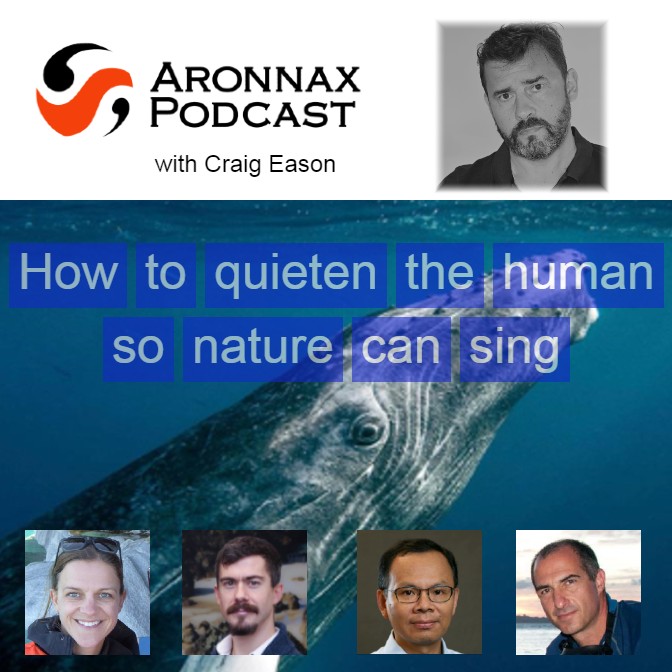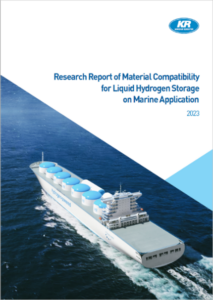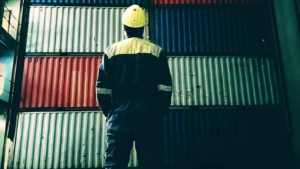The oceans are getting noisy. Very noisy. Shipping has long been seen as a culprit, but all the other ocean economies are making their own noise too. An anthropogenic noise imprint across all the seas and oceans. Can anything be done about it? And will the decarbonisation of shipping help make ships quieter?
There’s a push to strengthen the IMO’s guidelines on underwater noise from ships, maybe to create something more mandatory. However that may take time.
In this episode of the Aronnax podcast I talk to scientists, lobby groups, technology professions about the ocean soundscape. I also look at a unique project that is using artificial intelligence to try and translate sperm whales, maybe even talk to them in the future.
Show transcript
Transcript
Craig Eason, Fathom World & Podcast Host (0’00””)
Hello again and welcome to the Aronnax podcast and in this episode we are looking underwater. So let’s start with some music to the ears of anyone who loves the sea. Whale song of course.
Whale song is perhaps the most well-known natural sound in the oceans, after perhaps the noise of waves crashing onto beaches and other weather-related sounds.
In this episode we are going to hear how anthropogenic or human- negated noise is potentially impacting the environment, and that means noise from ships as well as other ocean economies, such as oil and gas and the growing number of wind farms. We will also hear how the clicks and noises of sperm whales could lead us to understand extra-terrestrial life.
There are a lot of different noises and before I get into the deep decibels of this podcast episode, I have a little audio test for you. What do you think this is?
The answer comes later in the programme. But first a quick look at what science calls the ocean soundscape, the noise that is in the oceans. What are the natural sounds of the oceans and what do they mean? Also, what is underwater sound? Have you ever wondered how your hearing is so different when you are in water?
Nathan Merchant CFAS (2’03”)
“Underwater sound is counterintuitive. We know we think of noise in human terms in terms of how, how far away something might annoy you if there was a noisy neighbour or whatever. underwater, because water is much denser than air and can travel 1000s of kilometres underwater.
So, there was an experiment done in the 90s, which would not be conducted today. Where there was a low frequency sound source, I think it was somewhere off of Southern Africa, which was then heard pretty much all the way around the world through propagation.
And it’s believed that in ocean basins, for example, there, there’s the potential for baleen whales to communicate right across them so many 1000’s of kilometres.
Craig Eason, Fathom World & Podcast Host (2’59”)
That is Nathan Merchant, he works at the UK’s Centre for environment, Fisheries and Aquaculture science or CEFAS, which is a UK government agency which advises Defra (that’s the UK’s Government Department for Environment, Food and Rural Affairs) on lots of things to do with the marine environment, including underwater noise. Nathan is CEFAs’s principal scientist for noise and bioacoustics.
Nathan Merchant CEFA (3’23”)
“So we’re primarily interested in noise pollution. So noise generated by human activities that could have an effect on underwater life. A lot of our work is to do with monitoring levels of underwater noise pollution. in UK waters. It’s one of our responsibilities. So, we have a network of hydrophones underwater microphones in English and Welsh waters. And we carry out the assessment of underwater noise levels in UK waters by mapping levels of shipping noise, in particular, using Aya ship tracking data in in UK waters. So, a lot of our work is trying to create visual representations of the soundscape in British waters.”
Craig Eason, Fathom World & podcast host (4’24”)
And that soundscape can be quite noisy already he says. There’re three types of noise in the oceans. There’s man made, or anthropogenic noise, there’s biotic and abiotic. Abiotic is natural noise int eh seas form rainfall, waves, surf wind, lightning strikes and the biotic noise is that generated from animals.
The worry is that the anthropogenic noise is drowning out and interfering with the biotic sound. One of the environmental groups that wants more to be done about the amount of anthropogenic underwater noise is IFAW, the International Fund for Animal Welfare.
Sharon Livermore IFAW (5’07”)
“Seismic, airgun surveys for oil and gas, naval sonar, pile driving for things like wind turbines or oil and gas platforms. Those are all impulsive noise. So, if you imagine a pneumatic drill outside of your house, with someone doing some building work, it could actually cause you to have hearing impairments as a result, especially if you are too close.
And with those kinds of impulsive noises, animals again, the sensitive animals like whales and dolphins, they can have an acute response, which could actually be something as serious as death, or severe injury, with kind of what we call ambient noise, which is produced by shipping, that increases the background noise level throughout the world’s oceans. And it travels incredibly efficiently.
So basically, everywhere in the world that a underwater hydrophone has been dropped in the water, you can hear shipping noise from the equator to the North Pole to the Southern Ocean, there is a recording of, of shipping noise in the background. And it travels particularly well, because it is directed downwards into what’s called the So Far channel, it’s this deep, deep sound channel.
And that allows the sound to travel over incredible distances and very, very efficiently. And it’s actually the same channel that, you know, whales, whales use to communicate with one another. So that’s where you’re getting overlap and the distortion that masks the kind of natural sounds of the ocean.”
Craig Eason, Fathom World & Podcast Host (6’37”)
That’s Sharon Livermore, IFAW’s director of marine Conservation. And she’s actively pushing for change to the 2014 guidelines that were written at the International Maritime Organization an underwater noise, but which she says have been largely ignored.
Sharon Livermore IFAW (6’55”)
“The guidelines, which, as you say, they were written in 2014, so, you know, it’s good seven, eight years ago now. And they, they were intended to provide general advice on reducing underwater noise from shipping to designers to ship builders to ship operators.
What we found, and actually sorry, you know, the Government of Canada has been very, very active in this space and they’ve done studies to kind of figure out, you know, why there is it not really been any uptake of these guidelines?
Why haven’t countries and shipping, done anything to try and action, this issue of underwater noise and we’re, we’re much more aware now of the impact it’s having on marine life on the marine environment.
But they’re just not being used to make changes to reduce underwater noise. And this study that Canada did commission a couple of years ago found that there were quite a few barriers that are identified, and the main one really is the lack of regulation.
So these guidelines are just that – they’re not mandatory. And, you know, for that reason, the shipping industry and countries are always going to prioritize things that are mandated as, as they, as they have to, that’s a requirement.
The fact they’re not legally binding, was one of the things.
Other things that were identified with were things like the measurements around underwater noise not being completely clear. They wanted to see more data that really demonstrates the impacts of underwater noise. And we’re sort of calling for baseline noise data as well.
Many of these barriers we believe are, you know, they’re not you know, we don’t need to do more research on the impacts of underwater noise. It’s well understood. Now, that noise is, you know, is a pollutant is recognized by the by UNCLOS, the International Law of the Sea, as a pollutant and under many other international agreements.
So, the evidence is that we know it impacts marine species from the smallest invertebrates to the largest whales. The point is really that industry, as they should, industry does priority prioritize the implementation of mandatory initiatives. And undertaking voluntary measures, such as the ones to reduce underwater noise are never going to be prioritized so that the guidelines need to be reviewed to kind of update them with the latest understanding of noise from shipping, but also to kind of figure out, you know, next steps. Like how we encourage uptake around this important issue?”
Craig Eason, Fathom World & Podcast Host (9’24”)
The IMO’s marine environmental protection committee has now agreed to relook at the guidelines and has passed it onto a subcommittee to review and make recommendations. IFAW and a number of other groups think that as the guidelines have been ineffective at reducing noise from ships, there should be something more mandatory in place
Sharon Livermore IFAW (9’44”)
“Well, the IMO is the competent agency to deal with underwater noise from shipping. So it would make sense for regulation on that particular pollutant to come from IMO.
And, you know, as the kind of authority on all matters relating to the environment from shipping, that does seem to be the obvious place for it to land. You know, the barriers that have been identified, they’re not, you know, not all of them are questionable. Many of them are Very, you know, they’re very real barriers, you know, how do we reduce noise from ships, and some of the suggestions in the original guidelines around countries identifying the noisiest 10% of the ships in their fleet, which, which are creating pretty much the majority of the noise from the shipping industry, those kinds of actions, which needs to be taken in order to determine, okay, where are our noisy old ships?
And what can we do with them to improve their efficiency around noise, so retrofitting them with, you know, new technologies, updating the propeller, which is the main source of noise for shipping, those kind of actions, which would have a huge effect on the entire global footprint, from the shipping industry, that, you know, that makes the most sense, really, in terms of what needs to be done. So it is identifying the ships that needs to be retrofitted, and, you know, basically getting on and doing it, but then also looking at the design of new ships and actually having noise as a factor that’s considered when those ships are being designed and built, because at the moment, noise just isn’t even on the radar for shipping architects and builders.”
Nathan Merchant CFAS (11’03”)
“There’s very clear evidence now, that underwater noise is affecting individual animals. So certainly, there’s very clear evidence for marine mammals. Lots of evidence emerging for a lot of fish species as well, as well as invertebrate species, which are the kind of less studied taxa.
What’s less clear is to what extent these effects that we can study in quite controlled circumstances or in field measurements on individual animals.
Does that that translate into population level effects, does that translate into ecosystem scale effects?
That question is a very difficult one to answer because there are so many other factors, human generated or natural, which effects, you know, population scale changes. So that’s a really tricky, tricky question. But a key question for policymakers is, you know – Is underwater noise really a significant threat at the large scale.
And so there, there are scientists who were dedicating a lot of time to trying to model the likelihood that this is having population scale effects. And of course, there are people who would advocate a precautionary approach and say, well, so many environmental indicators in marine habitats are not doing very well, at the moment, there’s a lot of cumulative pressure on the marine environment from human activities. And perhaps noise is a relatively easy pollutants to control. And it’s also one, which, you know, if you take noise out of the water, then it’s pretty quickly gone away. Whereas some of the pressures on the marine environment are very kind of persistent chemical things that will be with us long before our time.”
Craig Eason, Fathom World & Podcast Host (13’07”)
Nathan and Sharon are also concerned about the other sources of noise in the marine environment from sources other than shipborne noise, particularly as nations build up their ocean economies.
Nathan Merchant CFAS (13’20”)
“It’s not just shipping, we were also concerned about what we call impulsive noise, which loosely is things that go bang. So you know, explosions, seismic surveys, pile driving of offshore wind farms are examples of impulsive noise. and international coordination is very much needed, not only because the animals that could be affected, you know, don’t respect whether they’re in you know, German or Dutch waters, it doesn’t really matter, you know.
We need to kind of think about managing our, our oceans, on a kind of ecosystem basis, and not according to national boundaries. But also, because of many of these activities are very international in nature.
When it comes to impulsive noise, we can kind of be, they tend to be activities, which you need to get permission to do anyway. So, if you want to build a wind farm, if you want to carry out a seismic survey to look for oil and gas beneath the seabed, then you need to get a license from a regulator and so through that process, we can look at imposing restrictions or providing incentives to do things quieter, when it comes to shipping it’s a very international business, you know, your ship might be owned by, you know, your listeners are no doubt familiar with this, but the shipping industry, involving many different players, and its regulation needing to happen at an international level, which, which is the whole purpose of the IMO is very difficult for a single country or a single port, even to have much of an effect on the, you know, to provide much of an incentive, shall we say, to make ships quieter, it needs it needs that coordination. So that’s, that’s absolutely why these efforts at the IMO or are the right forum for that to happen.
At the same time, you know, other international fora can help to kind of provide impetus to that, you know, it may be that, you know, coordination within Europe, for example, can help to show how some of these regulations could be implemented and to do some of the science that will be needed to, to make sure that they’re well evidenced.”
Craig Eason, Fathom World & Podcast Host (15’52”)
But when it comes to the noise from a ship there are things that can be done. Many of the solutions that are suggested will also help reduce a ships fuel bill, a double benefit one may say as reducing noise, reduces fuel consumption and therefore reduces CO2 and other emissions into the air.
I spoke to Dr Qing Yu, he’s director of technology at the US classification society ABS wo told me that on a technology perspective ships generate three types of noise in general, that’s airborne noise, shipborne noise which has a lot to do with passenger and crew comfort on a vessel and then the underwater noise generated by the ship as it sails though the water.
Dr Qing Yu, ABS (16’34”)
“Underwater noise, the main source of noise is from propeller. So that’s the main noise generation mechanism, let’s say on board, and also for commercial ships, those machineries on board will generate noise as well, either through noise emission directly into water of the structural vibration, because those machinery to the equipment on board we’re causing a structural vibration and then structural vibration will generate underwater noise emission.
The third way is a relatively small part of the equation, it is the flow around the ship will also cause some element of underwater noise.
So, typically, the noise level generated by propeller will include two components. One is the so-called tonal noise. The frequency of that part of the noise is a multiple of propeller rotation frequencies.
And then the second part is so called the broadband noise, which is very much associated with cavitation of the propeller. Once the propeller generates cavitation bubbles, and the bubble will burst, and we’re talking not just one or two bubbles in it is a collection of huge amount bubbles, and then the underwater sound generated by the bubble bursting will create a broader band underwater noise.”
Craig Eason, Fathom World & Podcast Host (18’19”)
“When it comes to the technologies that one can put onto a ship – you have a white paper that he published earlier this year, and there’s a list of ducts and fins etc. that can be installed. How does a duct – I’ve heard about the like the Mewis Duct being used to improve efficiency of a vessel so that the fuel consumption can be improved by one or two precent, but how does a duct, or these technologies, work in actually reducing the sound? And are they better fitted other technologies that are better fitted for certain ship types or certain types of propulsion? So, an azimuth, for example, is it better than a direct line propeller attached to a diesel engine?
Dr Qing Yu, ABS (19’05”)
Yep, that’s a good question actually.
When we are looking to know, kind of interesting design topic is the co-design of energy efficiency and underwater noise reduction. And that a ducted propeller or fins, designed to reduce the resistance to vessel, and can contribute to certain level of reduction of underwater noise.
Remember, for underwater noise, one of the main sources is from the propeller. When we can design those ducts and finds in a certain way, they can regulate the flow coming into the propeller, and then they can adjust the pattern of the cavitation, the initiation of the cavitation, so that can, again to certain extent, reduce the cavitation induced noise.
And, again, the design of those energy saving devices so far, is pretty much focused on energy efficiency.
One of the main research topics right now is to look into the possibility to combine the design for energy efficiency and the design for underwater noise reduction.
And certainly for propulsion system, there are some very specific designs, especially for the propeller. You can put those like twisting edge and put it in those specific type of propellers that are used to reduce the noise.
And those are used for some time, especially for military vessels, but for commercial vessels they are still relatively less used than the common off-the-shelf propeller designs.
Craig Eason, Fathom World & Podcast Host (21’08”)
“One of the technologies that I’ve read about that began many, many years ago, and I’ve seen the US Navy using it is air bubbles, they used a system called the Prairie-Masker to produce bubbles coming out of the hull and even out of the propeller, to mask the sound prints of the vessels.
It has naval and military implications to make sure that they weren’t detected by submarines, enemy submarines, but likewise, I’ve heard of air bubbles being used an air curtain, I think it’s called being used around pylons being driven into the ground to reduce the noise being spread of the of the pile I’m driving.
And I know and I know also that there’s a lot of work now with air lubrication systems on ships, again, another system that is being used to improve the efficiency of the vessel.
But you mentioned a second ago that it was the bubbles bursting in the cavitation of the propeller that creates some of the noise. So how can we have noise from the bubbles bursting, but at the same time, have bubbles protecting the oceans from noise? Can you explain that a little bit?”
Dr Qing Yu, ABS (22’22”)
“Yeah, the cavitation generated bubbles will have different shapes and different frequencies and also the bursting of the bubble will generate a high energy noise emission.
For those bubbles generated for air curtain, or now we have other type of energy saving technologies such as air lubrication also generates bubbles. Those bubbles are different from the bubble due to the cavitation and then there’s a way to control the pattern of those bubbles, the size of those bubbles, and also the distribution of those bubbles.
So, for those underwater noise generating cavitation, essentially the only way that we can do is to regulate the cavitation occurs, either reduce the speed or change the way that those cavitation bubbles are generated through the operation measures or design considerations.”
For air lubrication system, and for the specific system designed by navies to mask the propeller generate the noise, the bubbles are generated again in a different way and also the noise created by those systems tend to be more, let’s say, much more broadband. Essentially, I can mask the noise from propellers.”
Craig Eason, Fathom World & Podcast Host (24’05”)
Dr to Dr Qing Yu, who is director of technology at the US classification society ABS, on the sources of underwater noise form ships and the good and bad of the air bubble.
Now, staying with the theme of underwater noise, let’s talk about whale communication and artificial intelligence. Sperm whales have a particular call, and according to scientists each individual pod, possibly individuals, can have a characteristic vocal sound,
Now, there’s an ambitious project has been launched in the Caribbean island of Dominica to try and see if scientists can use recent advances in artificial intelligence and machine learning to translate the clicks of the sperm whale.
It’s called project CETI Where CETI means the cetacean translation initiative. It’s non-human communication. It is a huge undertaking, and a well-funded one at that bringing together experts in cryptography, robotics, linguistics, artificial intelligence, marine biologists.
It’s developing a whale listening system of hydrophones and even robotic fish to listen to a specific pod of sperm whales in a 20 km square area off the Caribbean Island.
Amongst the team is Professor Dan Tchernov the project’s Chief Operations Officer, and a marine biologist at Haifa University in Israel. I spoke to him about the project and the possible outcomes Professor Dan Tchernov, COO Project CETI, Marine Biologist Haifa
University, Israel (25’43”)
“With all the machine learning, technology and AI, this is all evolving really quickly, in the last decade, maybe now it’s possible finally to decipher communication between sperm whales, because they’re using actually something close to Morse Code, so, just single clicks with different positions and will put always with the same structure like five notes or three notes depends on the pod and already there is quite a bit of annotated data with which we can start with, to show proof of concept.
And the big idea behind it is to finally break the institutional barrier, and therefore, for the first time perhaps, trying to communicate with these mammals, or actually any other creature on their own term, mainly listening to try and understand the communication.
But finally, perhaps also sending messages and getting replies. This is called CETI also because it is theoretically the training wheels for the humankind to try and reach out to other civilizations, if they ever, if ever we encounter them, to understand how to try and decipher and communicate with something very, very different.
Craig Eason, Fathom World & Podcast Host (27’02”)
Dan Tchernov on sperm whales and the attempt to translate their underwater sounds using artificial intelligence and the potential in the future to apply such learning to other species, possibly even extra-terrestrial.
Audio examples (27’24”)
END (28’24”)
related news
More aronnax episodes
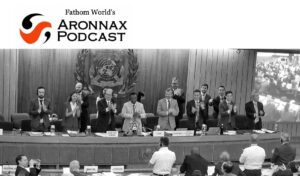

Aronnax: July 3rd
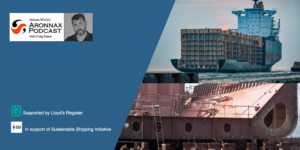
Aronnax: June 29th – Ships and their steel: Turning it green
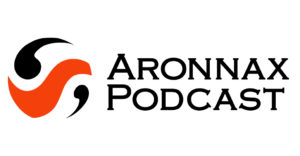
Aronnax: June 19th

Aronnax: June 4th
























